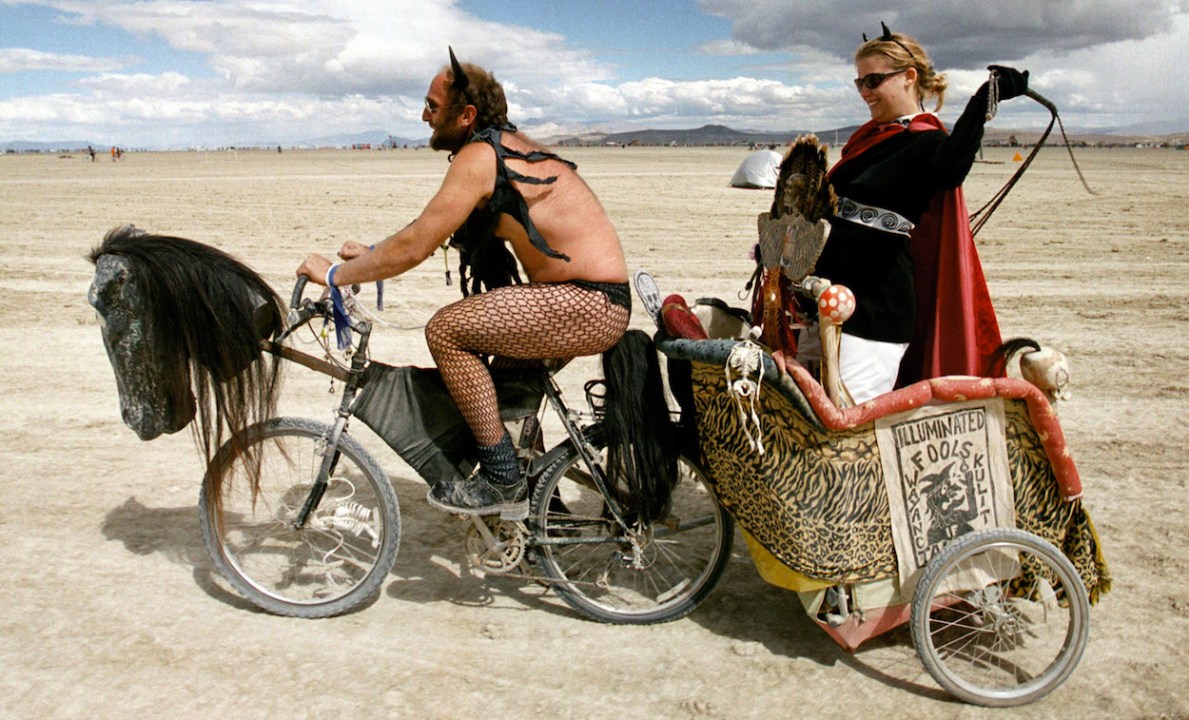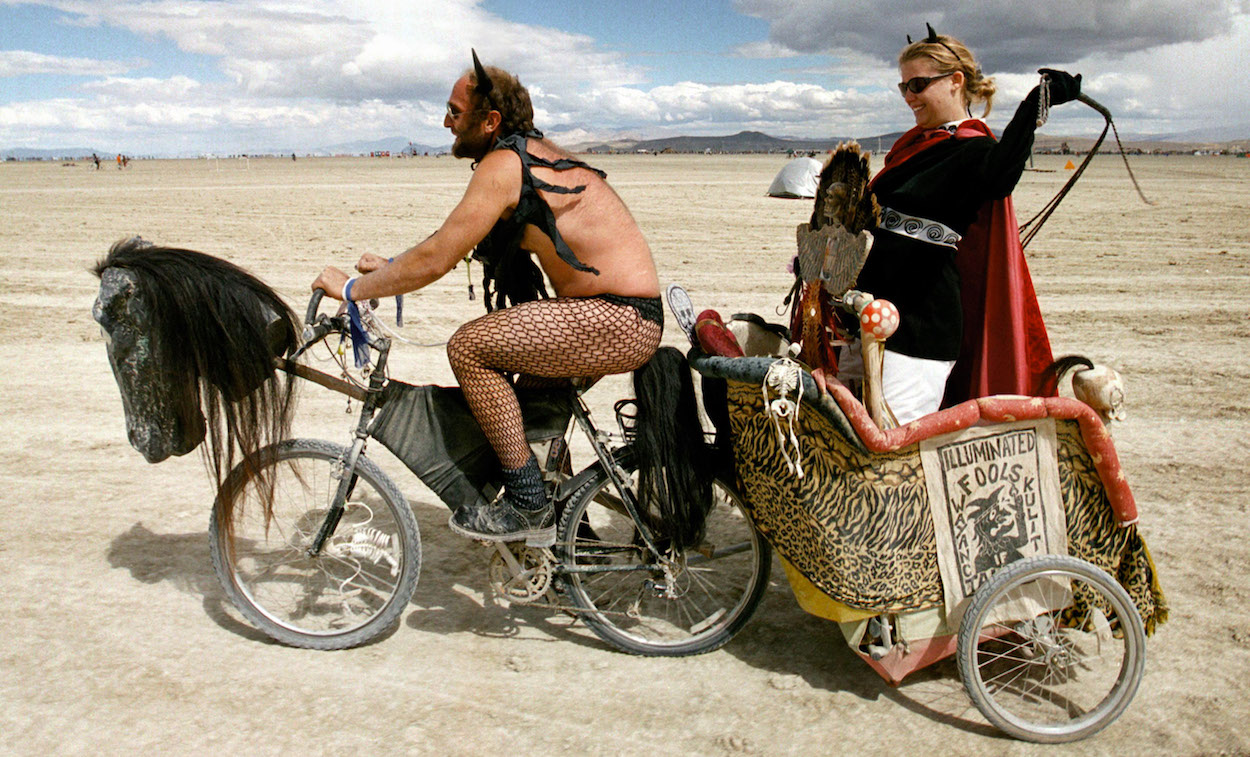In the summer of 1986, two men, Larry Harvey and Jerry James, built an eight-foot-tall wooden effigy of a man and set fire to it on a beach in San Francisco. The event – an impromptu bonfire attended by several dozen of their closest friends – spawned what has since become a cultural phenomenon: an event seen by some as the ultimate rejection of capitalism, and by others as a giant drug-fuelled knees-up in the desert.
I’ve noticed the changes in the six years that I have been going to Burning Man
Thirty-seven years on, Burning Man still culminates in the razing of a wooden sculpture, but since then both ‘the man’, and the event itself, have grown exponentially. This year the structure measured nearly 80ft in height, and more than 70,000 people gathered to watch as it was set ablaze. And among them, rubbing shoulders with the traditional cast of ravers, hippies, and hedonists, is a growing celebrity clientele, made up of internet influencers, corporate titans, and Silicon Valley billionaires.
That Burning Man would change was perhaps inevitable. As well as a worthy exercise in communal living – and what its founders termed ‘radical self-reliance’ – the event is also, for many, a lot of fun. The creation of an ephemeral city in the desert (think Mad Max meets Cirque de Soleil) tends to give rise to the sort of orgiastic atmosphere in which gravity-defying art installations and hallucinogenic drugs almost seem de rigueur.
But as it has grown, Burning Man has become increasingly elitist. Tickets which once cost the equivalent of £30 when the event transferred to the Nevada desert in the early 1990s now sell for ten times that price. According to figures compiled by festival organisers, more than half of those who attended last year’s event reported a household income of more than £80,000 a year.
I’ve noticed the changes in the six years that I have been going to Burning Man. The community spirit still exists, but it’s been diluted by the folks who touch down in the desert in their corporate jets, often accompanied by stylists and assistants, as well as a tangible sense of entitlement. A sharp rise in the number of so-called ‘plug and play’ camps that feature luxury RVs and celebrity chefs has turned the place into what the festival’s own newspaper has described as an ‘adult playground for rich bucket-listers.’
Citing the growing expense of attending the event that it was set up to chronicle, that same newspaper – the Black Rock City Weekly – has announced that it is going out of business. In an eviscerating front-page editorial its editor, Adriana Roberts, wrote that Burning Man was now guilty of catering to what she called ‘the well-heeled… who prefer their survivalist desert camping to be a little less survivalist’, and went on to declare that after 14 years in existence, the paper was closing down. ‘This (place) ain’t for poor people’ she added.
As if to test the survivalist instincts of the new generation of Burning Man attendees (or ‘burners’ as they are known), this year the weather was to pose a special challenge. After five days of clear skies and radiant sunshine, the heavens opened, dumping twice the average rainfall for the time of year on the desert landscape, turning the dust into clay. We awoke on Saturday to roads made impassable by ankle-deep mud and dire warnings to conserve food and water supplies ‘because nobody knows how long we are going to be here.’
That, and the organizers’ decision to close the festival gates to anyone seeking to enter or leave, was initially greeted with acceptance, but when Sunday brought with it further showers the mood began to change. This was, after all, the day that people were due to start heading home, yet by then the burning of ‘the man’ had twice been delayed, travel around the site had been banned, and – with the gates still locked – tens of thousands of people were effectively stranded in the muddy morass that now constituted their home.
Stuck in our RV, rain lashing the windows, my friend Chuck and I began plotting our escape. There were rumours of people in heavy vehicles whose attempts to leave had been thwarted by the mud. We agreed that we were ready to leave despite the risks and as the late-evening downpour turned to drizzle we decided that if it stayed dry for long enough overnight it was worth taking our chances along a boggy back-road.
Steering a big vehicle across that slippery terrain in the pre-dawn darkness was touch-and-go at times and there were moments when all the wheels could do was spin feebly. But as we made it out of our encampment, the ground grew smoother and the journey easier. We cheered as we reached the edge of the desert, and a few hours after reaching the nearest city, Reno, it was announced that the gates had reopened – prompting a mass exodus and long delays on the single-lane highway leading out of the festival.
Along with ‘participation’ and ‘civic responsibility’, another of the principles of Burning Man adopted by Larry Harvey was ‘leave no trace’, a reference to the intended state of the festival site once the gathering had come to an end. The last few days have revealed just how far the new generation of ‘burners’ had fallen short, after the local sheriff, Jerry Allen, complained about the ‘numerous’ vehicles and items of camping gear that had been left strewn across the desert. He spoke as well of people ‘lashing out at each other’ as they queued for hours to leave. Adherence to foundational principles – or the lack of it – may ultimately prove an even greater threat to the future of Burning Man than the weather.







Comments